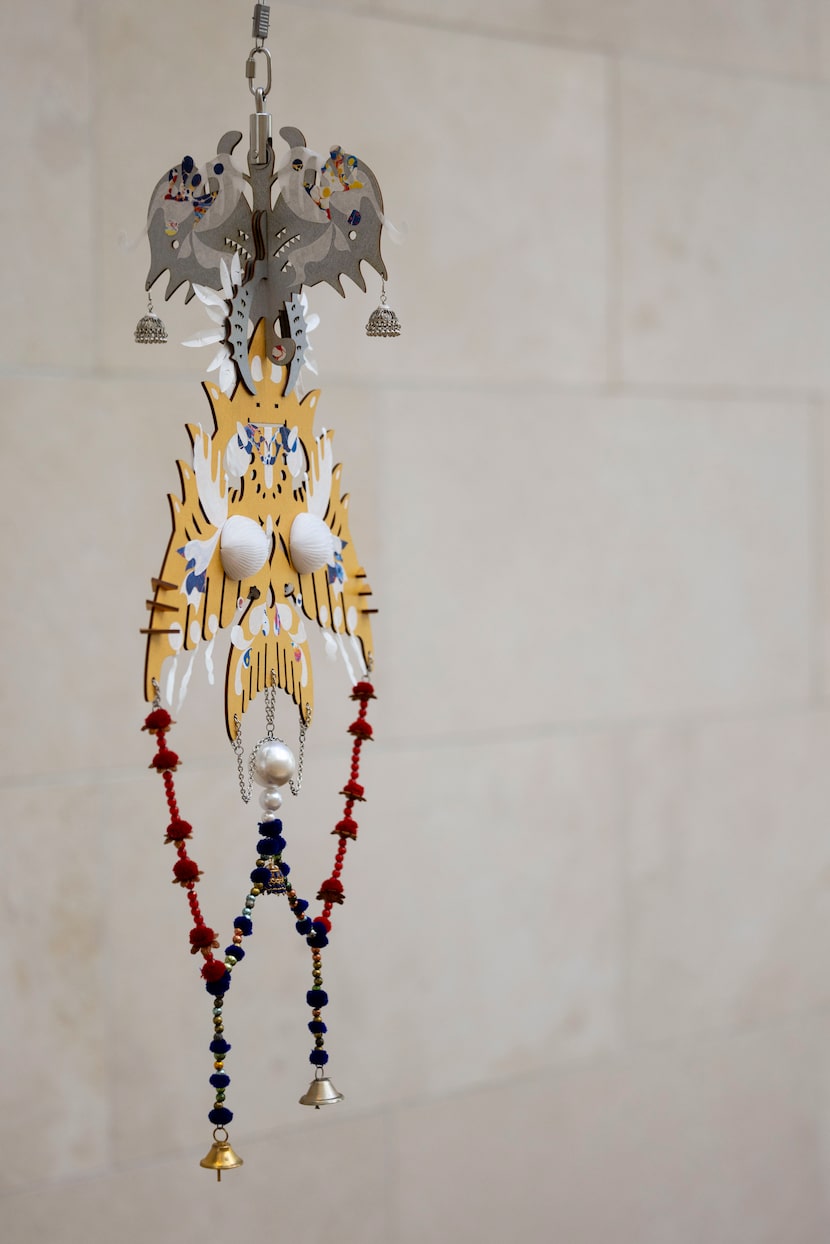Haegue Yang’s sculptural work, seen around the world and now in Dallas at the Nasher Sculpture Center, stages an encounter between two kinds of force: the organic and the mechanical.
The drama in this encounter comes from a question: In a globally connected art world ever more dominated and bound together by technological machines, what will be the fate of delicate local microcultures, whether these be flora, fauna or cultural traditions?
While Yang’s work draws strength from premodern sources such as folk traditions, mythical creatures and plant and animal life, it is also embraced by the same global art world whose ceaseless electronic communication and constant jet travel serve to detach and disconnect these sources from the communities who nurture them and give them meaning.
Viewing Yang’s marvelous works, I was entranced by the glimpses they offer of beautiful and unfamiliar cultural traditions and somewhat saddened by a sense of their remoteness from their origins, a long way from home.

As you enter the Nasher’s crisply defined, gleaming galleries, fluttering overhead are a group of intricate suspended sculptures known as Airborne Paper Creatures. Drawing from work that Yang showed last year in Pakistan at the Lahore Biennale, these creatures include elements from Punjabi culture, such as goat bells and hair ornaments. Their lightness and decorative nature help create a festive atmosphere, as though you were about to sit down to a banquet.

In the next gallery, a couple dozen diminutive, foot-tall sculptures called Mignon Votives play on the cross-cultural human practice of marking a particular moment and place as special, even sacred. One group of votives, the bonsai-like Seedpods, resemble offbeat garden mutants, while the other group, Pebble Parades, look like precariously balanced cairns with banknotes and a few twigs tucked between the stones.
The Mignon Votives were inspired by the idyllic gardens created by 17th-century poet Yun Sŏndo on a remote island off the southern tip of the Korean Peninsula when he was exiled there for political reasons.

Although the Nasher installation gamely re-creates the setting of Yun’s gardens, with a ground cover of moss, river rocks and even the calming sounds of breaking waves, I felt that the votives’ petite size was somewhat overmatched by the grand scale of the surrounding galleries, and I wondered whether they would be viewed to better effect in a more intimate setting, such as a domestic shrine.
As in a well-plotted horror movie, the climax of the show occurs upon descending into a dark basement room filled with weird and alarming creatures: an experience that the ground-level works hint at but do not entirely reveal.
For the duration of the exhibition, Yang has renamed the Nasher’s lower-level gallery the “Cenote Observatory,” which suggests being trapped in a sinkhole at a wildlife preserve, and filled it with some of her best-known creations. Only a few visitors can enter the darkened room at once, to preserve the full effect.

Like a Mardi Gras carnival of monsters, decked out with accessories ranging from brightly painted red turbine vents to jewelry, bells and yarn, the basement creatures are posed as if they are ambling around with an abandon that recalls Phyllida Barlow’s exuberant turn at the Nasher. These range from the Eva Hesse-like Woven Paired Archi-Heads to the virus-shaped Sonic Rotating Whatever.
At the center of the monster phalanx is a seven-part ensemble called Umbra Creatures by Rockhole, a team of mutants in shaggy black coats who greet the viewer quizzically. One of their relatives, a relaxed Imoogi, or Korean dragon, appears to have escaped from the basement and lounges contentedly by the fountain outside the building, having crashed the exclusive club of traditionally modernist works that occupy the Nasher’s garden.
Far from Romantic-era stereotypes of the tormented and debauched artist, the modern culture industry instead tends to reward the kind of highly focused, relentlessly disciplined type-A personality that also flourishes in business and the professions (see also: Taylor Swift). Yang herself is ferociously productive (one catalog credits her with more than 1,400 works), and profiles of the artist have alluded to her solitary, even monastic, devotion to her work.

It’s a paradox that the same well-oiled art-world machine that efficiently distributes Yang’s production from Odense, Denmark, to Mexico City (to cite some recent announcements) would ostensibly be devoted to the quirky, artisanal traditions that animate her work. Tentatively, in Yang’s encounter between the living and the mechanical, I’d call it a draw, for now. Whether her work is absorbed into a global monoculture, or instead contributes to nurturing the local traditions it draws from, will be up to those who receive it.
Details
“Haegue Yang: Lost Lands and Sunken Fields” continues through April 27 at the Nasher Sculpture Center, 2001 Flora St., Dallas. $10 for adults, $8 for DART riders, $7 for seniors, $5 for educators and students with ID, free for children under 12, military and first responders with ID, SNAP EBT card holders, and members. Open Wednesday through Sunday from 11 a.m. to 5 p.m. 214-242-5100, nashersculpturecenter.org.




